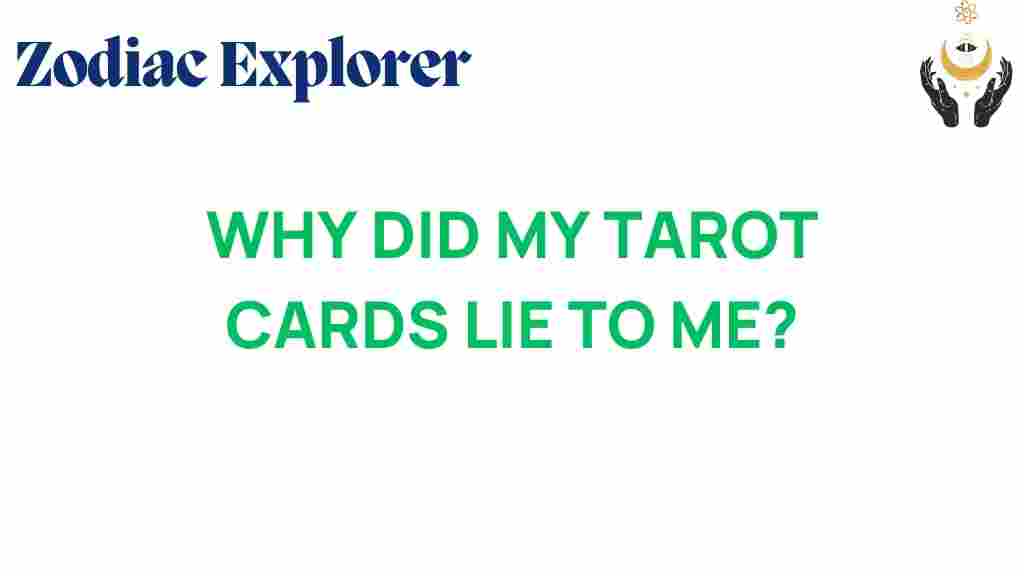The Mystery Behind Tarot Cards: Why They Seem to Mislead Us
Tarot cards have fascinated people for centuries, often seen as tools for divination that unlock the mysteries of fate and provide spiritual guidance. Their rich symbolism and intricate interpretations captivate both seasoned practitioners and curious newcomers. However, many find themselves perplexed by the outcomes of their readings, leading to misconceptions about the nature of tarot cards and their purpose. In this article, we will delve into the mystery behind tarot cards, explore their symbolism and interpretation, dispel common myths, and ultimately understand how they can enhance our intuition and spiritual journey.
Understanding Tarot Cards
Tarot cards are a deck of 78 cards used for divination, each card depicting various symbols, archetypes, and images that convey different meanings. The deck is typically divided into two main sections: the Major Arcana and the Minor Arcana.
- Major Arcana: Comprising 22 cards, the Major Arcana represents significant life events, spiritual lessons, and karmic influences. Cards like The Fool, The Lovers, and The World are powerful symbols in the tarot journey.
- Minor Arcana: This section consists of 56 cards divided into four suits: Wands, Cups, Swords, and Pentacles. Each suit relates to specific aspects of everyday life, emotions, challenges, and material concerns.
The Role of Intuition in Tarot
Many practitioners emphasize the importance of intuition when working with tarot cards. Intuition acts as a bridge between the reader and the cards, allowing for a deeper understanding of the messages being conveyed. Here’s how intuition plays a crucial role in tarot readings:
- Connection: Intuition helps readers connect with their inner self and the energy surrounding the reading, leading to more insightful interpretations.
- Personalization: Each reading is unique; intuition allows the reader to tailor the interpretation to the client’s specific situation.
- Symbolic Interpretation: The symbolism in tarot cards can evoke emotional responses and insights that logic may overlook, making intuition essential for accurate readings.
Symbolism and Interpretation in Tarot
The symbolism of tarot cards is vast and varied, with each card telling its own story. Understanding the symbolism is key to accurate interpretation. Here are some common symbols found in tarot:
- Wands: Represent creativity, action, and passion.
- Cups: Symbolize emotions, relationships, and intuition.
- Swords: Indicate conflict, intellect, and challenges.
- Pentacles: Relate to material aspects, security, and career.
When interpreting a tarot reading, the context of the question and the positions of the cards are crucial. Readers often use various spreads, such as the Celtic Cross or Three-Card Spread, to gain insights into different areas of life.
Common Misconceptions About Tarot Cards
Despite their popularity, several misconceptions surrounding tarot cards persist. Understanding these can help clarify their true purpose:
- Tarot Cards Predict the Future: Many believe tarot cards provide definitive answers about the future. In reality, they offer guidance and insights that can influence future choices.
- Tarot Is Only for Spiritualists: While often associated with spirituality, anyone can use tarot cards for self-reflection and personal development, regardless of their spiritual beliefs.
- Readings Are Set in Stone: Tarot readings are not absolute; they reflect the current energies and situations, which can change based on decisions made.
Step-by-Step Process of a Tarot Reading
Conducting a tarot reading involves a series of steps that can enhance the experience and accuracy of the interpretation:
- Set Your Intention: Before beginning, clarify your question or intention. This focus will guide your reading.
- Choose Your Deck: Select a tarot deck that resonates with you. Each deck has its unique artwork and energy.
- Shuffle the Cards: While shuffling, concentrate on your question to infuse the cards with your energy.
- Lay Out the Cards: Depending on the spread you choose, lay out the cards in the designated positions.
- Interpret the Cards: Begin interpreting the cards based on their meanings, positions, and your intuitive insights.
- Reflect: After the reading, take time to reflect on the insights gained and how they apply to your situation.
Troubleshooting Common Issues in Tarot Readings
Even seasoned tarot readers can encounter challenges during readings. Here are some tips to troubleshoot common issues:
- Feeling Stuck: If you feel unsure about a card’s meaning, take a moment to breathe and connect with your intuition. Sometimes, a simple pause can reveal insights.
- Misinterpretation: If the reading feels off, consider rephrasing the question or exploring different spreads for clarity.
- Overwhelmed by Symbols: Focus on one or two key symbols from the cards instead of trying to analyze everything at once.
Conclusion
The mystery behind tarot cards lies not in their ability to predict the future but rather in their capacity to guide us through life’s complexities. By understanding the symbolism and embracing our intuition, we can unlock the profound insights that tarot offers. While misconceptions may lead some to view tarot cards as misleading, a deeper exploration reveals their true purpose: providing clarity, fostering spirituality, and enhancing our decision-making abilities.
As you embark on your journey with tarot cards, remember that they are not a definitive answer to your fate but a powerful tool for personal growth and reflection. Embrace the guidance they offer and allow your intuition to lead the way.
For more information on tarot and its applications, check out this comprehensive guide. If you’re looking for a deeper understanding of spirituality, explore this resource for insights and practices.
This article is in the category Myths and created by ZodiacExplorer Team
